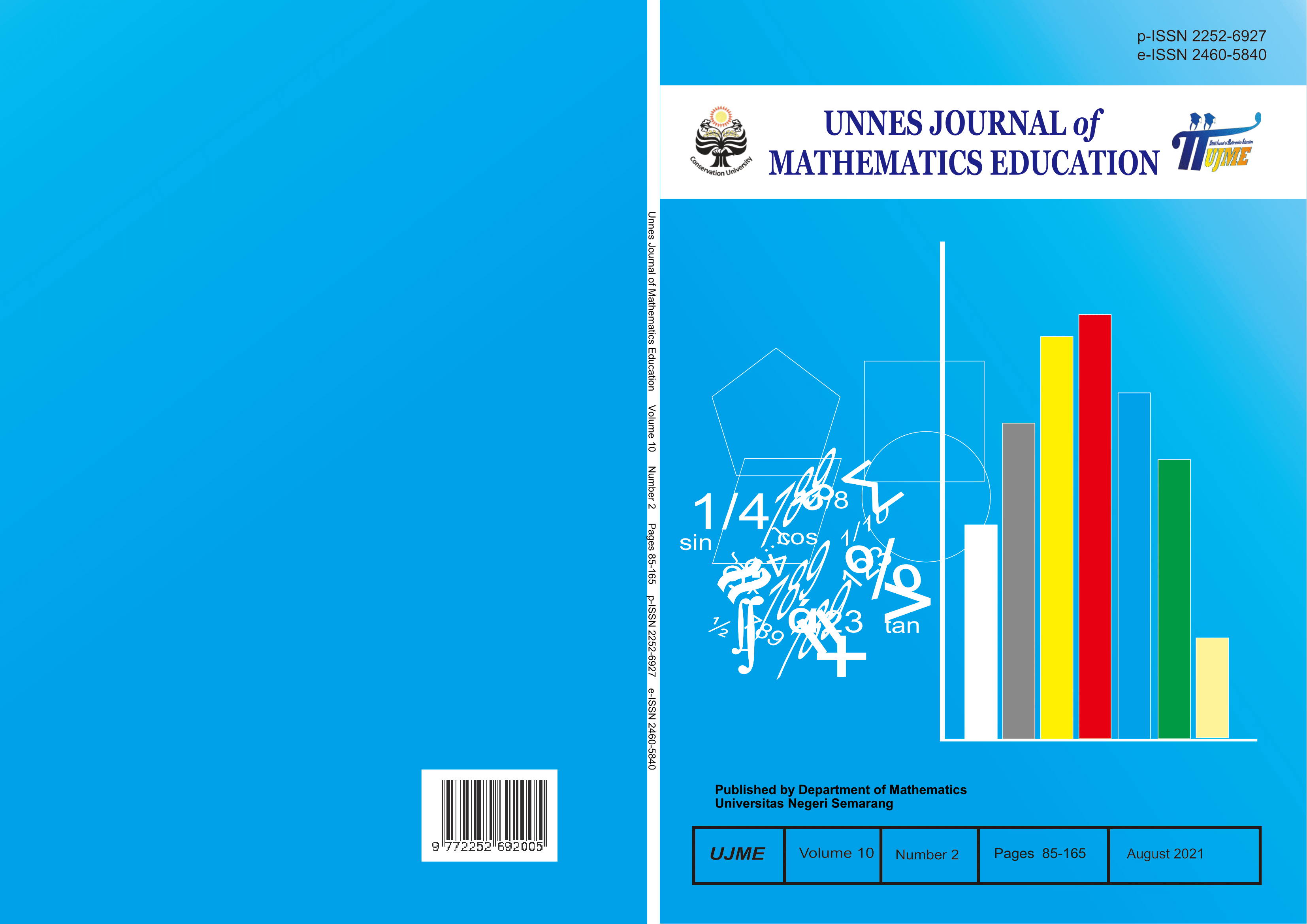Mathematical representation ability and confident character assisted by Schoology with the NHT method and thematic approach
##plugins.themes.academic_pro.article.main##
Abstract
This study aims to determine the students’ mathematical representation ability and confidence character assisted by Schoology with the Numbered Heads Together (NHT) method and thematic approach and describe the mathematical representation ability based on the character of self-confidence. The subjects of this study were students of class VIIF and VIIH, one of Junior High School in Semarang. The method used is a mixed method. The results of the study show that: (1) The students’ mathematical representations ability and confident character assisted by Schoology with the NHT method and thematic approaches are better than learning without Schoology; (2) the mathematical representation ability based on the character of self-confidence is (a) students with high self-confidence implement indicators visual and symbolic representations; (b) students with medium self-confidence implement indicator symbolic representation; and (c) students with low self-confidence not implementing of indicators visual, symbolic, and verbal representation abilities.
##plugins.themes.academic_pro.article.details##
References
Clark, V. L. P., & J. W. Creswell. 2008. The Mixed Methods Reader. Thousand Oaks: Sage Publications.
Hidayah, I. 2018. Pembelajaran Matematika Berbantuan Alat Peraga Manipulatif Pada Jenjang Pendidikan Dasar dan Gerakan Literasi Sekolah. Prosiding Seminar Nasional Matematika. Semarang: Universitas Negeri Semarang.
Hidayah, I., & Sugiarto. 2015. Model of Independent Working Group of Teacher and Its Effectiveness towards the Elementary School Teacher’s Ability in Conducting Mathematics Learning. Procedia-Social and Behavioral Sciences, 214:43-50.
Huda, M. 2017. Cooperative Learning (Metode, Teknik, Struktur, dan Model Penerapan). Yogyakarta: Pustaka Pelajar.
Kusmana, A. 2017. E-learning dalam Pembelajaran. Lentera Pendidikan: Jurnal Ilmu Tarbiyah dan Keguruan, 14(1): 35-51.
Lince, R. 2016. Creative Thinking Ability to Increase Student Mathematical of Junior High School by Applying Models Numbered Heads Together. Journal of Education and Practice, 7(6): 206-212.
Morse, J. M. 2016. Mixed Method Design: Principles and Procedures. New York: Routledge.
Muhamad, N. 2017. Pengaruh Metode Discovery Learning untuk Meningkatkan Representasi Matematis dan Percaya Diri Siswa. Jurnal Pendidikan UNIGA, 10(1), 9-22.
Murtiyasa, B. 2015. Tantangan Pembelajaran Matematika Era Global. Prosiding Seminar Nasional Matematika dan Pendidikan Matematika UMS. Solo: Universitas Muhammadiyah Solo.
NCTM. 2000. Principles and Standards for School Mathematics. Reston: NCTM.
Rusman. 2015. Pembelajaran Tematik Terpadu (Teori, Praktik, dan Penilaian). Depok: Rajagrafindo Persada.
Sabirin, M. 2014. Representasi dalam Pembelajaran Matematika. Jurnal Pendidikan Matematika, 1(2): 33-44.
Sapto, A.D., Suyitno, H., & Susilo, B.E. 2015. Keefektifan Pembelajaran Strategi REACT Dengan Model SSCS terhadap Kemampuan Komunikasi Matematika dan Percaya Diri Siswa Kelas VIII. Unnes Journal of Mathematics Education, 4(3).
Sugiyono, 2016. Metode Penelitian Pendidikan. Bandung: Alfabeta.
Wijaya, M. 2012. Pengembangan Model Pembelajaran E-learning Berbasis Web dengan Prinsip E-Pedagogy dalam Meningkatkan Hasil Belajar. Jurnal Pendidikan Penabur, 11(19): 20-27.
Yudhanegara, M. R., & K. E. Lestari. 2015. Meningkatkan Kemampuan Representasi Beragam Matematis Siswa Melalui Pembelajaran Berbasis Masalah Terbuka. Majalah Ilmiah SOLUSI, 1(4): 94-103.
